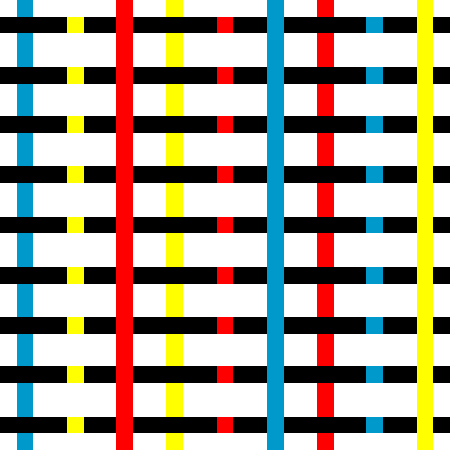Play with contrasts of horizontal stripes
Slider
contrst of horizontal stripes
Button
repeatedly click to change the color of the vertical stripes
Spot 07 shows an entire palette of different colour phenomena and their varied interaction. Similar to Spot 08, the effect here comes from simultaneous contrast (light and dark spots on the centre stripes, (see also Spot 01, picture 10), the Kanizsa effect (see Spot 06), the neon colour spreading effect (see Spot 05), the assimilation effect (see Spot 09), the Bezold effect (see Spot 04 and Spot 08), the transparency effect and the spatial illusion that results (see pictures 1 to 10 in the appendix to Spot 01), as well as size illusion (see Spot 01, picture 11). There is even a little of the bamboo effect in this palette (see Spot 01, picture 13).
We will first examine the apparently different shades of blue in the three stripes of blue using our Bezold effect test method (see Spot 01, pictures 19 and 20 and Spot 08) and make comparisons with a corresponding picture from Spot 07. Although the changes in colour and brightness triggered by the Bezold effects point in the right direction, they in no way provide a complete explanation for the illusion of the three stripes. Deciphering the individual effects is a difficult problem that remains to be solved.

Interesting features of the pictures in Spot 07 are the illusions at the edges (the stripes appear to have wavy borders), the spatial illusion that remains unexpectedly stable even when the background is quite grey and illusions surrounding the spaces between the three equidistant stripes that results from the appearance of a spatial layering into foreground, middleground and background.
Three identical shades of blue, yellow and red are perceived differently, the three coloured stripes appear to be at different levels (spatial illusion), to have wavy borders and to be different distances apart.

The simultaneous contrast at the spots where the black and the superimposed coloured stripes cross is very evident: lateral inhibition is the reason for this lighter appearance. The spatial effect is produced by the presence of T sections (concealment features, see also Spot 06). The brain interprets the upright of the T as a background element and the horizontal bar of the T as a foreground element. In the case of red and blue in the middleground, a weak neon colour spreading effect can also be observed (see Spot 06), which grows more intense the further the viewer moves away from the picture. Spot 07 is a further development of this picture, which is limited to the colour cyan and which makes it possible to study the influences of the picture's background. A similar optical illusion has been published in America, independent of our discoveries; this is known as White's Illusion.